**Warning for Graphic Pictures**
“We’ll meet again
Don’t know where, don’t know when
But I know we’ll meet again, some sunny day.
Keep smiling through, Just like you always do
‘Til the blue skies drive the dark clouds far away
So will you please say hello to the folks that I know?
Tell them it won’t be long. They’ll be happy to know
That as you saw me go, I was singin’ this song…”
Vera Lynn, 1939
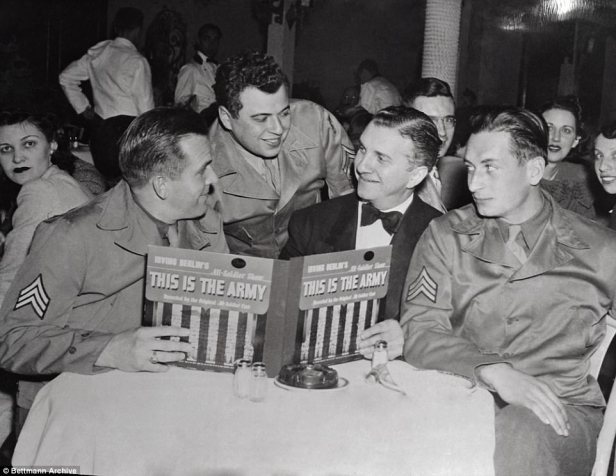
The year was 1942, and on a frigid November night, the Film District of Boston was bustling with life. Everyone wanted to spend the Saturday night out on the town, whether it was eating out with family or dancing the night away with a date. The Boston clubs were hopping with big band and lounge singers, filled to the brim with young military men in full regalia (WWII was the headlines of all newspapers), and none was more packed than the Cocoanut grove.
The Cocoanut Grove was filled far beyond capacity with revelers having a wonderful time, but by the end of the night nearly half of the them would be dead, and the city would be reeling from one of the most horrific events in Boston’s history.
An event that seems to have been lost with time.

As I walked down Stuart street past the Wang and Wilbur theatres, I marveled at how busy this area was even on a frigid November weeknight. It was November 29th, and seventy five years and one day since one of the single greatest losses of life in a fire in US history. I was on my way to stand in the spot where it had happened. As I walked around the large Revere Hotel and onto Piedmont street, I marveled at how suddenly the sound of city life passed.
In this quiet Bay Village neighborhood, you would never know you were in the heart of Boston. There was not a soul around as I found the only markers to commemorate one of Boston’s most horrific tragedies.
The first I noticed was a street sign for Cocoanut Grove Lane, formerly Shawmut Extension and renamed in 2013. The small street did not exist in 1942, as after the Grove was demolished the area was reconfigured.


Currently, the majority of the Grove’s footprint rests beneath the Revere Hotel (formerly Raddison). Most of the rest is now covered by condominiums, but one can still stand on Cocoanut Grove Lane and be within the spot where the club once stood. I stood there myself.
There was significant controversy during the construction of the condominiums in 2014, regarding the second marker of the fire.

The memorial plaque was installed in 1993, and stood at approximately the spot where the infamous revolving door once was. For years it was the only reminder of the tragedy, despite the scope of its impact.
In 2014 the lot near the plaque, which had stood empty since the Grove was demolished, was purchased to erect luxury condominiums. The plaque was removed to keep it safe during construction, with the promise it would be reinterred afterward. However after only a few weeks, rumors of complaints from the new residents arose. According to some, they felt the plaque was too “sad” and was a constant reminder of a tragedy they wanted no part of. They also feared tourists seeking the plaque would loiter.
After a lot of back and forth, the plaque was eventually moved a short way down the street so it was no longer in front of the condos. The move hurt many who had intimate connections to the fire, but the urge to forget won out over the duty to remember.

The Cocoanut Grove started its life in 1927 as a speakeasy, pioneered by gangland bosses and bootleggers. In the early thirties it was run by Charles “King” Solomon, until he was gunned down by members of a rival gang. Ownership passed to Solomon’s lawyer, Barney Welanskey, who saw great opportunity in the club scene when prohibition ended in 1933. He reimagined the club, modeling it after the well known Cocoanut Grove club in LA, hoping to to bring some Hollywood flair to the east coast. His vision paid off, and the Cocoanut Grove became one of the poshest places to be seen in Boston. Its legal occupancy was 460, but on nights like the 28th, the number of guests soared into the 1000 range.
Only 11 days previously Barney had unveiled the newest addition to the Grove, the Broadway Lounge, after annexing the building next door.

In the VIP section of the Grove on the evening of the 28th sat cowboy movie star Buck Jones, feeling ill but urged to come out to a celebration by his manager. He was touring to promote a flick, and guests of the Grove craned their necks and chattered in excitement to get a glimpse of a real life celebrity.
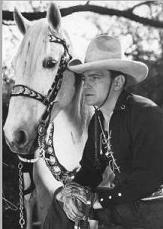
The basement of the building was the cramped and dimly lit. Called the Melody Lounge, it was a favorite spot for young couples. Cooing singer and pianist Goody Goodelle was their entertainment for the evening. At about 10:15pm she was a few songs into her set when a small commotion broke out in the back corner of the lounge. There was a fire.
A few frequent guests and employees let out nervous laughter at the flames creeping up the paper palm tree decorations. This was far from the first time this had happened, and the tiny fires were always snuffed out quickly.

Don Lauer, a Marine Private, sat enjoying the evening with friends when he realized this would not be like those other times. The fire shot quickly up to the ceiling, which was draped loosely with fabric. Recognizing the precarious situation, Don leapt up and pulled out his pocket knife, slashing and cutting at the fabric in an attempt to separate the burning bit from the rest and stop the spread.
In another world, Don could have been successful, and the patrons of the Melody Lounge could have laughed and cheered as the handsome marine saved the day. Goody would have begun singing once again, and upstairs, no one would have even known about the tiny, inconsequential fire.
But that was not what happened in our world.
Don worked hard but it wasn’t enough, and flames rushed in a wave across the ceiling of the lounge, sending the guests into panic. chairs were overturned and screams rang out as people flooded to the only exit they knew; the staircase from which they’d entered. Goody Goodelle and a few others dropped to the floor of the lounge to escape the intense heat above them.
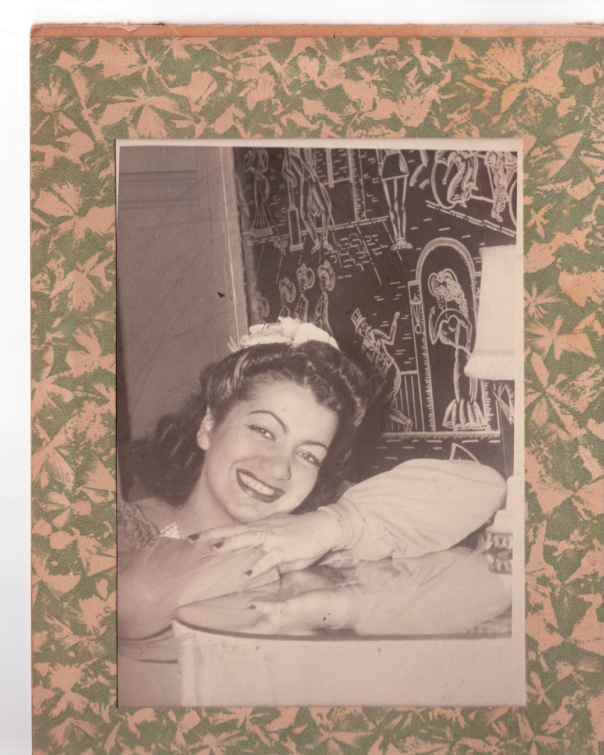
As people flooded the staircase, panicked and shoving, they were met with an exit door. The only trouble was, it was welded shut.
Barney Welanskey had sealed off nearly every exit of the club in some way, as he felt people had been skipping out on their bills. Some had bars across them, some were hidden behind decorations and drapes, and one was even bricked up.
As patrons scrambled against the sealed door, those in front were crushed beneath the weight of the crowd. Falling one by one, others atop them, they became a writhing pile of bodies suffocating in thick black smoke.
As smoke funneled upstairs into the main room of the club, patrons in the dining room and seated at the Caricature Bar looked up in confusion. Before they had time to react, the fire below hit the main source of power for the Cocoanut Grove, and everyone was plunged into darkness.
Tables were overturned and dishes smashed as people ran for the exits they could no longer see. The obvious choice was the set of revolving doors at the front of the club, the way most had entered. As the mass of panicked people flooded against it, it became immovable. When some managed to slip out, the next few became trapped, squished in the doors and soon buried beneath others. The pile of bodies in front of the main entrance reached chest high.
Some people ran for a back exit, and some were chased by smoke around a corner into the Broadway Lounge, where 21 year old Coast Guardsman Clifford Johnson was seated with his date for the evening when panic ensued.
Once more, before most could react in any way to the chaos, another twist of fate occurred. In the main dining room, some patrons had managed to bust the back door open, and the sudden influx of oxygen to the starved fire led to an explosive fireball that rocketed through the club and into the Broadway Lounge. Now the entire Grove was engulfed in flames. Since the fire’s start, only five minutes had passed.

In the chaos, Clifford lost his dates hand. He searched for her desperately, and in the process helped countless others out of the inferno. He ran back into the Grove nearly half a dozen times by some accounts, and on his final exit he collapsed to the ground outside with third degree burns over 50% of his body, some down to the bone. He later found out his date had already escaped.
Downstairs in the Melody Lounge, Goody and a few others, mostly employees, used rags soaked in water or urine to survive, as the smoke and fire was so intense it was nearly impossible to breath and would burn the inside of ones lungs. Those few who had not run to the stairs to escape the basement lounge would be some of the only ones from the Melody to survive. The rest lay in a charred pile in the staircase nearly waist deep. Don Lauer was among those that died.
Upstairs, sickly Buck Jones was overcome by smoke so fast he collapsed in own seat, laying against the table.
Employees of the Grove used their knowledge of the building’s layout to find alternative back exits. Some escaped through windows into a back alley, and some even hid inside the walk in fridges.
A few blocks away, several firefighters were responding to a car fire when they smelled smoke. Only two weeks previously, a horrific fire known as the Maverick Square Fire had claimed the lives of six of their own. As they hurried toward the source, they encountered a crowd of screaming and begging people, and the most popular club in Boston burning.

The firemen worked as fast as they could, but the scene was chaos. As they tried to break open the revolving door, the second influx of oxygen led to a second fireball which incinerated the bodies jammed in the door, and killed anyone still alive within the mass. As the rescuers desperately tried to pull bodies out, limbs broke off in their hands.
Other rescue workers went around the other side of the building. Some encountered a man trapped in a small window he had broken partway through. They tried to pull him out but were unable, and soon the man was screaming in agony as he burned alive in front of them. The helpless men tried spraying him with hoses, but to no avail.
As the firemen fought the intense fire, their hoses were freezing to the ground, as the outside temperature dropped.


As “survivors” were helped out of the fire, many gasped and collapsed to the ground. The intense shift between the immense heat inside and the freezing cold outside sent their bodies into shock. Many who had appeared uninjured died of pulmonary edemas before they even arrived at the hospital, or soon after. Most of those who were severely burned did not live long, but Clifford arrived at Boston City Hospital and was worked upon fast, receiving an experimental new antibiotic called Penicillin. He received many skin grafts, the first few sloughed back off of him, but they finally took and he survived.


At the Grove, the fire was finally brought under control. The entire ordeal had lasted only 15 minutes.
Once the rescue workers got inside, they were met with a sight akin to hell on earth.
Dead bodies lay in piles everywhere, some burned so badly that there was nothing left but a blackened trunk. One woman was found dead in an interior phonebooth, with a phone still clutched in her hand. At the bar, the fire and fumes had overtook people so fast they hadn’t had time to leave their seats and still had drinks in their hands. In the VIP section, Buck Jones was found severely burned, barely alive. He was taken to the hospital where he lingered for days before he died.
In the wreckage, some survivors were recovered. They had only survived because they were buried under dead bodies which shielded them.
Fireman John Collins would recall years later, being one of the first into the Melody Lounge that night. He was shocked to see a beautiful woman sitting serenely at a table.
“W-what are you doing here?” He questioned, but the words had scarcely left him when he realized the woman was dead.

Children lost their parents, and parents lost their children that night. Entire families were destroyed. As the hours passed, the death toll climbed to a staggering amount. The final agreed total was 492 lives.
The number was 32 more than the allowed occupancy of the building.
The youngest victim was 15 year old Elenor Chiampa.

Bodies lined the street that first night. Local morgues were filled beyond capacity, and bodies were stored in nearby warehouses as a result.

At the hospital as he recovered, hero Clifford Johnson and one of his nurses fell in love, and were later married. They moved to Missouri. In a cruel twist of fate, Clifford Johnson was in a terrible car wreck in 1957 and was trapped inside his jeep, where he burned to death. In some ways he was yet another victim of the Grove.
One of the other collateral victims of the Grove was Francis Gotterina. He lost his wife in the flames, and jumped to his death six weeks later.
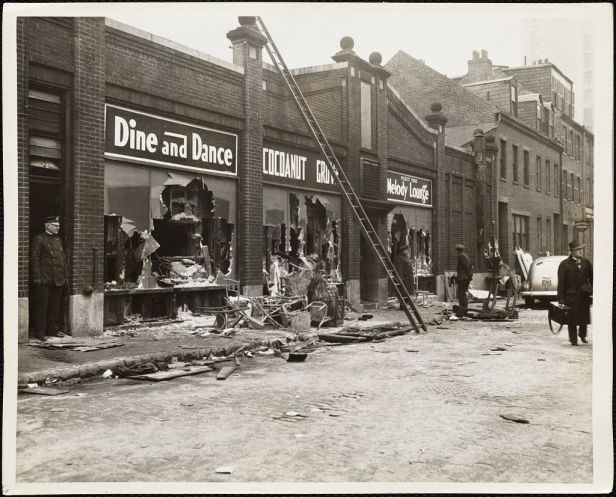
As the city reeled from the tragedy, the people began to seek answers. How could something like this have happened? How could it have been prevented? Who was to blame?
16 year old Stanley Tomaszewski told his story the next day. He was a busboy working in the Melody Lounge the previous night. A waiter had noticed that one of the lightbulbs over a booth had been unscrewed (perhaps to give the couple seated there more privacy) and Stanley had been ordered to go fix it. Stanley had difficulty seeing in the dark, so he lit a match to screw the bulb back in. He did so, then put out the match. According to him, he did not start the fire. But he hoped his story would help.

The trouble was, other eyewitnesses confirmed that the fire had started in that same back corner, and the first flames had raced up the palm tree that Stanley had been under only moments before.
The press caught wind of the story, and someone to blame had been found.

Stanley, who had been working to fund care for his sick mother, had become an easy villain to the story, a careless teen who had essentially murdered nearly 500 people.
Stanley conceded that it was possible his match was the culprit (What else could it have been?) and for years he was an outcast, literally spat on and harassed.
The authorities took pity on him and tried to clear his name, but Stanley’s life was never really the same.
Over the years, scientists and firemen would work together to try to discover the possible cause of the fire. Some felt the cause was a short circuit in the wall, based on the scorch marks behind Stanley’s palm tree. Others suggested that the fires cause was less important than the explanation as to ‘why’ it was so intense. One explanation was the use of flammable methyl chloride in the cooling units. The gas had replaced freon due to wartime shortage. Another culprit was the highly flammable and toxic decorations in the club. While burning they had released poisonous gases or melted and fell upon victims, intensifyini the death toll. And the most obvious safety concern of all was surely the six different exits to the club that had in some way been blocked or hidden by Barney Welansky.
Though the fire raised awareness and increased fire safety laws, the fact was it was already in violation of many laws already in place. Welansky had many important connections, all the way up to Boston’s Mayor Tobin who was a friend. These connections allowed him to run the club however he wanted, and thus put hundreds of people in danger.

Welansky was tried and convicted of 19 counts of manslaughter, and sentenced to up to 15 years in prison. He was pardoned 4 years into the sentence by the now Governor Tobin, due in part to his advance stage of cancer. He died only 9 weeks later, and was quoted as saying “I wish I’d died with the others in the fire.”
As far as settlements for the victims and their families, they only got about $150 when all was said and done.
In the years that followed the tragedy, many improvements were made in fire safety. Exit doors could no longer swing inward, revolving doors had to be flanked by regular doors and/or collapsible, exit signs had to be clearly visible and on a separate power source from the building so they stayed lit, and decorations had to be fire retardant.
Along with safety improvements, another positive outcome from the tragedy was the advancements it paved the way for in healthcare. Doctors learned much about burn treatment and successfully tested penicillin. This knowledge would be indispensable during the War years that followed. Added to this was studies and awareness in the fields of psychology, as the disorder PTSD (Post Traumatic Stress Disorder) was rampant among Grove survivors. The first ever paper written on PTSD was on one such survivor.
Many of the children of survivors and rescue workers alike recalled severe repercussions from the fire. Some were never the same. Some developed phobias of crowds or cramped interiors. Some refused to talk about that night at all.
But despite all that was learned and all of the ripples outward from the tragedy, years later it lay nearly forgotten in Boston’s past.
The Titanic disaster got an award winning Hollywood movie and taught so many about the subject that it became a household name. But the Cocoanut Grove only got a plaque on the ground.
Some felt that it was because we did not respect and learn from history that 100 more innocent lives were needlessly lost in the Rhode Island Station Club fire of 2003. It was nearly a carbon copy of the Grove, 60 years later.

When I visited the site, it was impossible to imagine the human suffering that had taken place there so long ago. But the most troubling part of it all seems to be the public’s willingness and eagerness to forget it ever happened.
Cocoanut Grove deserves a statue, it deserves a documentary, it deserves a Hollywood movie. It deserves to be taught, and remembered. Doing so is the only way to prevent such a tragedy from ever happening again.
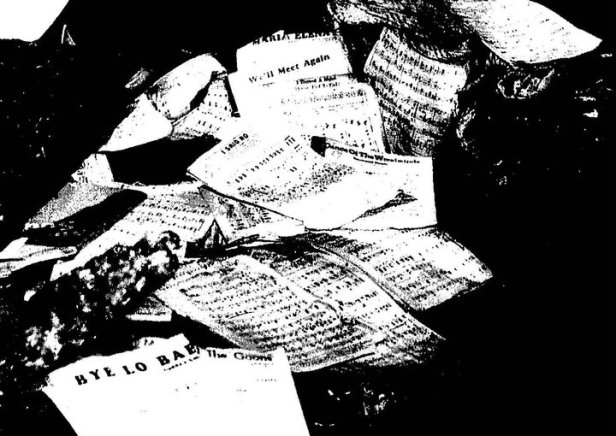
For more photos, click here

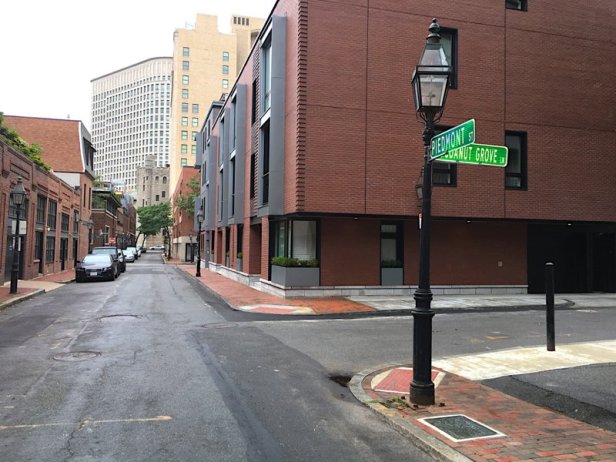
I love following your posts. You hit home with the grove. I wasn’t born until 1955. I was totally obsessed with the heartache & tragedy of this disaster,all because of the obituary of Clifford Johnson. My parents always bought the daily paper. It was the record American back then.when I read about his flight I bought the book. Mr.johnson,as I remember was taken to the whidden hospital in Everett, mass. Where he went underwent months of skin graphs.he did fall in love with his nurse and marry. While riding in his jeep it overturned.the last thing I remembered reading in the paper was his jeep burst into flames!! It said Mr. Johnson died a terrible death in a fire!! Tragic story.
The photo titled the “Melody Lounge” is not the Melody Lounge. It is of the new Broadway Lounge that was only opened 11 days before the fire. The Melody Lounge was a windowless basement room, and the bar was not curved. The glass block windows are the notable feature of the Broadway Lounge, because they could not be broken out for people to escape. That photo is wrongly titled all over the internet, even Getty Images has it wrong.
Thank you for the catch, I will edit that!
Hello,
I’m so very late to this tragic story. I want to add 2 very divergent stories.
My mother was to go to the Grove on that fateful night to meet up with some of her fellow employees. Her mother , (according to my mother) told her to stay home. I know how rambling this account is and since my mother has been dead for 35 years, I have no way to verifying this…. but she didn’t go to the Grove and was forever changed. And i mean this because , from my earliest age, she would never, ever, go into a store or building if there were those swinging glass doors. Each and ever time that we encountered them , she would point at them , tell me the reason to never, ever, go into a building with doors like those and she would look for another entrance .
Secondly: I had the delight and honor to work with a surgeon who had been in his internship at the time of the Grove fire. This was very much in his later years. He was an intern at one of the teaching hospitals in Boston at the time of the fire. He shared that it was wonderous to see this thing called Penicillin being introduced and used on the wards of the various hospitals taking care of the victims.
How this topic came up in the middle of surgery in 1987…well, I have no idea, but operating rooms lend themselves to shared confidences and ruminations. While he was relating this I felt like I was present in the middle of that very young medical student/ intern from that very long ago moment. I could see him as a young man grappling with the enormity of the horror of what he was experiencing in that hospital in 1942.
Thank you for letting me share this with any of you who look at this post.
Thank you for sharing! This tragedy effected so many families in MA and there are so many incredible stories surrounding it.